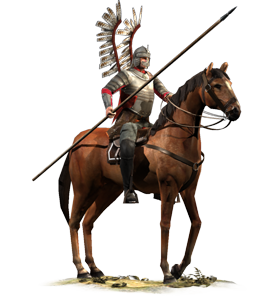Difference between revisions of "Winged Hussars (ETW Unit)"
(→Tactics) |
|||
| Line 1: | Line 1: | ||
| − | {{Unit|image=[[Image:Winged_Hussars.png]]|Class= | + | {{TW Unit|image=[[Image:Winged_Hussars.png]] |
| − | + | |Class=Heavy Cavalry | |
| − | + | |Unit Size=60 Men | |
| − | + | |Weaponry=Lances | |
| + | |Region=Eastern Europe | ||
| + | |Recruitment Cost=1140 | ||
| + | |Upkeep Cost=340 | ||
| + | |Building Requirements=Army Board | ||
| + | |Tech Requirements=None | ||
| + | |Attributes=<li>Paths Seldom Trod</li> | ||
| + | <li>Inspires Nearby Units</li> | ||
| + | }} | ||
| − | + | [[Image:Euro_polish_winged_hussars_icon_cavl.png]] Polish Winged Hussars make a brave sight in any battle, their wings giving them an imposing and intimidating appearance. | |
| − | |||
== Overview == | == Overview == | ||
| Line 13: | Line 20: | ||
| − | |||
| − | |||
| − | == | + | |
| + | ==Details== | ||
In the Grand Campaign, Poland-Lithuania may train up to ten regiments of Winged Hussars. Winged Hussars are a combination of a lancer unit and heavy cavalry which can devastate enemy targets with their charge, yet also have a heavy advantage in pitched combat. They are particularly devastating against small groups of enemies, as their charge alone will kill most of them. Winged Hussars are also very effective against cavalry. | In the Grand Campaign, Poland-Lithuania may train up to ten regiments of Winged Hussars. Winged Hussars are a combination of a lancer unit and heavy cavalry which can devastate enemy targets with their charge, yet also have a heavy advantage in pitched combat. They are particularly devastating against small groups of enemies, as their charge alone will kill most of them. Winged Hussars are also very effective against cavalry. | ||
Revision as of 11:44, 28 April 2013
![]() Polish Winged Hussars make a brave sight in any battle, their wings giving them an imposing and intimidating appearance.
Polish Winged Hussars make a brave sight in any battle, their wings giving them an imposing and intimidating appearance.
Overview
These troops are usually members of the nobility, for only they can afford the expense involved in being a member of this prestigious force. They are armed with long lances, sabres and pistols for fighting at close quarters. Their armour and elaborate uniforms, complete with two towering, feathered wings, set them apart from other “hussars”, and make them appear to be a kind of cuirassier to the uneducated eye. Their charge with levelled lances and fearsome appearance is enough to strike terror into many foot troops.
Historically, the Polish Winged Hussars had been inspired by the successes of the Hungarian hussars. Over the centuries since their establishment, they became a heavier, armoured force and, if possible, even more convinced of their elite status. The truth was somewhat different: as the 18th Century dawned, the Winged Hussars were outmoded and, in the face of disciplined firepower, no longer quite as effective as they had once been.
Details
In the Grand Campaign, Poland-Lithuania may train up to ten regiments of Winged Hussars. Winged Hussars are a combination of a lancer unit and heavy cavalry which can devastate enemy targets with their charge, yet also have a heavy advantage in pitched combat. They are particularly devastating against small groups of enemies, as their charge alone will kill most of them. Winged Hussars are also very effective against cavalry.
However, Winged Hussars are not invulnerable. Although they fare better than regular cavalry when charging line infantry frontally, they will still take heavy losses if they attempt to do so. They are also vulnerable to stakes and concentrated fire of all types.
